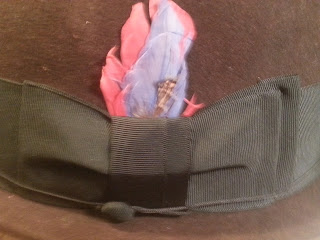A man’s cravat gives him a distinctive look after he has
carefully knotted it to suit his mood.
Your cravat is actually a utilitarian object d’art and after being
knotted, twisted and clamped or pinned all day the fabric becomes distressed
and must be allowed to relax and return to its original shape. During the course of the day the densely
woven fibers of your cravat are stretched out of shape so it is important to
store them in a manner that will allow the fabric to achieve a balanced
structural recovery. Vintage Cravats can generally be worn at any time including work and leissure however historic cravats should only be worn on special occasions and must be removed or replaced when eating or handling any chemicals. If you stain your vintage cravat take it to a professional conservator specializing in textile cleaning and conservation. Remember that your vintge/historic cravat is a one of a kind item that has survived the test of time, it can be irreversibly damaged or destroyed in a matter of seconds requiring hours of potentially costly conservation to restore it to its former handsomeness.
STORAGE: The best way
to store a cravat is to roll it loosely and store it away from direct sunlight
and dust. Rolling the cravat allows it
to return to its original shape and air out again and it is a natural way of
removing folds and wrinkles. It is best to store rolled cravats in a drawer or a closed container with proper vintillations holes away from direct sunlight.
DAMAGE BY SUNLIGHT:
Direct sunlight will eventually discolor the delicate dyes on all
natural fibers such as silk, linen, cotton, wool and rayon but it will even
discolor polyester. Storing your fine
cravats in a place away from light and dust will ensure that the fabric remains
crisp and colors will remain vibrant. As a rule of thumb if cravats or any vintage/historic textile is to be stored out in the open or exposed to light the level of illumination should not exceed 50 lux and all UV light should be filtered out to prevent damage.
DIRT AND DUST: When
dirt particles from dust are allowed to invade the interstitial areas of the
weave of a fabric it can cause irreversible discoloration and
deterioration.
MOLD AND FUNGUS:
Keeping your cravats away from all moisture ensures that mold; bacteria
and fungus will not be able to grow on and literally eat your fine cravats
away. If you ever suspect any fabric
has been compromised by mold or bacteria a fungicide suitable for textiles
should be professionally administered to preserve the garment.
DAMAGE BY OILS AND STAINS:
Men who have beards or facial hair such a goatees must be careful that
the oils and other conditioners and fragrances applied to facial hair does not
have a chance to soil their fine cravats.
With new cravats it may be a simple matter of a good dry cleaning but
with delicate vintage fabrics a curator’s touch is required. Never machine or hand wash a vintage cravat
you will cause the fabric to shrink and the unstable dyes will bleed. Contact a textile conservator at a local
museum for best results.
DAMAGE BY INSECTS AND VERMIN: As surely as you treasure your collection of fine vintage clothing insects and vermin look to them as potential food. Insects such as moth larvae, silver fish, mites, cockroaches, beetles, etc., feed on the protien and cellulose contained in the plant and animal fibers of which your vintage wardrobe is composed. Since these verimi will consume your vintage treasures without regard for thier value you must be sure to protect them properly so that no access is possible. Vintge Cravats should be rolled and stored in drawers or acid free paper boxes.
DAMAGE BY WATER: A
common way to damage a vintage cravat is to get it wet. When washing ones hands at the sink the
cravat will naturally drag the counter top absorbing any liquid it sees. Water is no friend to your vintage cravat,
the dyes and pigments used to create the wonderful designs you love are rarely
colorfast and will bleed or fade to your horror. Older fabric is not as supple as modern
fabric and exposure to water can cause irregular shrinking and deformation of
the woven matrix of your cravat.
PROPER STORAGE CLIMATE: Vintage and historic textiles should be stored at temperatures between 65 degrees and 75 degrees Fahrenheit and at around 50% humidity. Storing cravats or any vintage/historic fabrics at high humidity levels will contribute to growth of mold, mildew and fungus; temperatures below 35 degrees humidity may cause a condition known as dry-rot.
NEVER DRY CLEAN VINTAGE NECKWEAR OR CLOTHING: Never take vintage cravats to the dry
cleaners because their delicate fabrics will be shredded and damaged beyond
recognition. The chemicals used to dry
clean modern dyes may fade or discolor old dyes and pigments and they may break
down the delicate fabric itself. If you
are eating or drinking while wearing your vintage cravat either cover it with a
bib or handkerchief or take it off completely until after you have
finished. Never adjust or touch your
cravat without washing your hands as the oils and dirt will leave a residue
that will eventually develop into a permanent stain.
IRONING AND STEAMING:
Be careful when attempting to iron or steam a vintage cravat especially
to ensure you do not burn or singe the fabric.
Remember, Polyester was invented around 1941 and many vintage cravats
may contain synthetic fabrics designed to enhance the texture, sheen and color
of the textile. Once a tie is burned it
is impossible to repair. Always use the
coolest setting and it is best to use a towel or other absorbent fabric between
the iron and the surface of the vintage fabric.
WHEN YOU TAKE OFF YOUR CRAVAT: As a rule always return your vintage cravat
to its safe storage place when you take it off.



























































